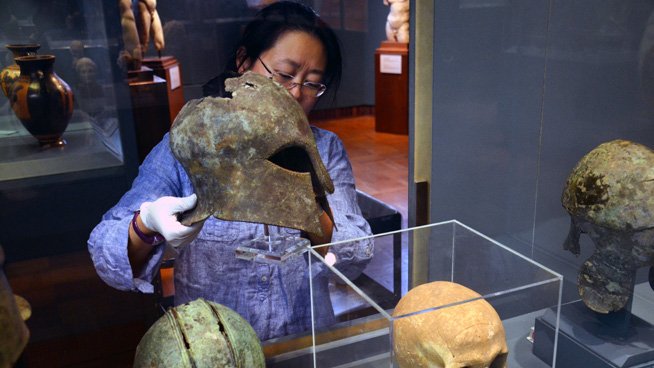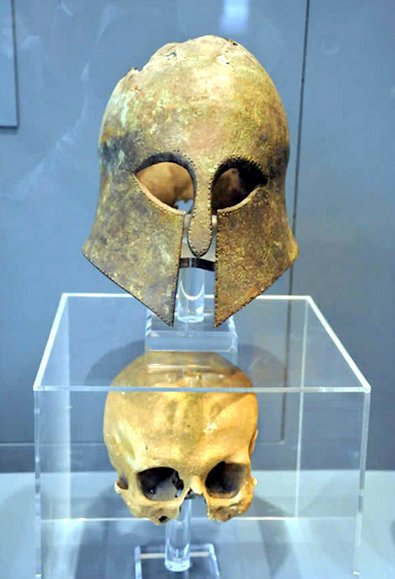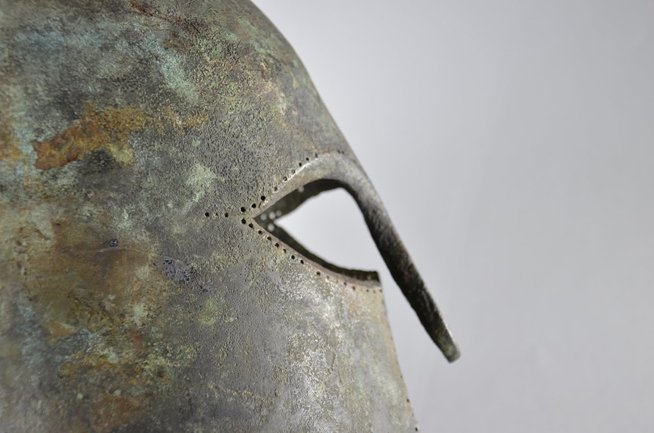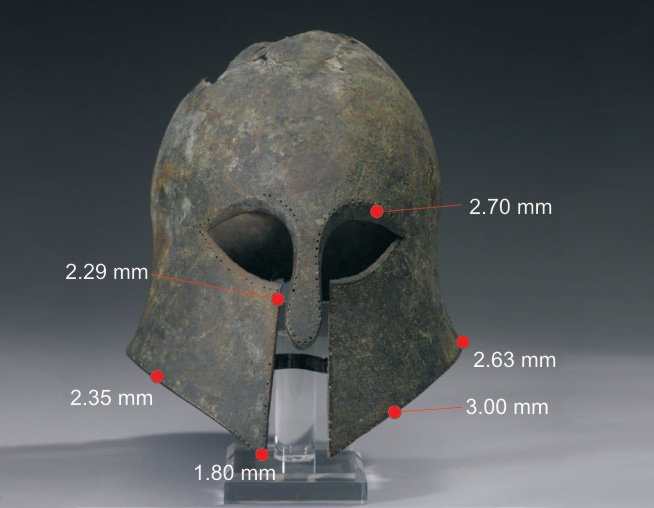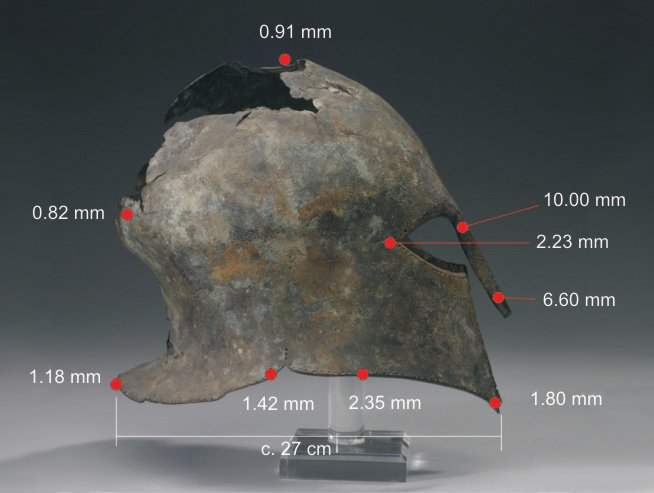In this video we will be exploring some of the most mysterious and bizarre discoveries. Enjoy!
Recent Archaeological Discoveries That Can't Be Explained
In the video below we will investigate the most recent archaeological discoveries that can’t be explained easily. Enjoy!
The Most Creepy & Mysterious Discoveries
In the following video we will be exploring the creepiest and most mysterious discoveries. Enjoy!
Most Incredible Recent Discoveries From Ancient Egypt & More
In the video below we will discuss about the most incredible recent discoveries from Ancient Egypt and much more. Watch the video to find out more!
Stunning Byzantine gem-covered gold earrings discovered in 800-year-old hoard in Germany
A trainee metal detectorist in northern Germany recently hit on something his mentor never expected: an 800-year-old hoard of gold jewelry and silver coins that hints at the area's trade connections.
The large hoard contained a dazzling collection of artifacts. "The hoard consisted of two very high quality gold earrings set with semi-precious stones, a gilded pseudo-coin brooch, two gilded stone-studded finger rings, a ring fragment, a small formerly gilded perforated disc, a ring brooch, and about 30 silver coins, some of them heavily fragmented," Ulf Ickerodt(opens in new tab), director of the State Archaeological Department of Schleswig-Holstein(opens in new tab) (ALSH), told Live Science in an email.
For decades, amateur and professional archaeologists have been working together to investigate the region of Schleswig-Holstein, and in particular the UNESCO world heritage site of Haithabu(opens in new tab). Known as Hedeby in Danish, the site was the second-largest Nordic town and was important to the Vikings between the eighth and 11th centuries. Haithabu was destroyed and abandoned around 1066, ending the Viking era in the region, but a century or two later someone purposefully buried the bag full of valuables nearby.
The detectorists came across the hoard while walking a well-studied patch of land. They reported the find to the ALSH, and a team of archaeologists then excavated the site to reveal items including silver and gold objects with preserved textile fragments adhering to them.
Perhaps the most remarkable items in the hoard are the two earrings. "They probably date to the time around and after 1100 and are in the tradition of Byzantine goldsmiths," Ickerodt said. The hoard also contained an imitation of an Islamic coin — an Almohad gold dinar — that had been made into a brooch. The Almohad caliphate was a Muslim dynasty that ruled over southern Spain and northern Africa between the 12th and 13th centuries. The 30 silver coins, minted during the time of Danish King Valdemar II, suggest that the hoard was buried some time after 1234.
The combination of Danish coins and western Mediterranean jewelry is particularly interesting and hints at the cosmopolitan nature of the area.
"Islamic coins were well known in southern Scandinavia between the 9th and 11th centuries," Marjanko Pilekić(opens in new tab), a numismatist in Germany who was not involved in this study, told Live Science by email. The money may have "reached this area en masse through long-distance trade contacts, robbery, tribute, among others," he said. "It was a popular practice to pierce or loop the coins and wear them."
The discovery of hoards is rare in Schleswig-Holstein, and it's unclear whether these items were personal property or stolen, if they were meant to be delivered to someone else, or if they were buried for ritual reasons. "Especially in times of crisis," Ickerodt said, "the resulting danger leads to the hiding of possessions." The Haithabu area was not abandoned for long after its destruction in the mid 11th century. Across the inlet of Schlei, Schleswig had begun developing as a settlement and trading center. "An extensive north-south and east-west trade network has developed here since the early Middle Ages, in which the Mediterranean region, the North Sea, and the Baltic Sea were integrated," Ickerodt said. "The hoard was certainly not put down by chance."
Why Aren't Africa and Europe Connected By A Bridge? Gibraltar Mega Projects
Why Aren't Africa and Europe Connected By A Bridge. Gibraltar Megaprojects. The initial primitive bridges just resembled logs thrown over water and didn't seem very secure. But as technology has advanced, societies have actually started to build truly impressive structures. The Dang Yang Kunshan viaduct, which holds the record for the world's longest bridge in the Guinness Book of World Records, is an excellent example.
There are locations, though, where bridges appear to be necessary but are absent. The Straits of Gibraltar is included in this. The Atlantic Ocean to the Mediterranean Sea is connected by this, which is significant globally. About 200 large ships passed through them every day. It's an essential route for Mediterranean communication with the outside world.
They became even more important after the official opening of the Suez Canal in 1869. The 100 miles long canal split Eurasia and Africa. And thanks to that, ships no longer needed to sail around Africa to get from the Indian Ocean to the Mediterranean and back.
The Dark Secrets of Belize's Black Hole
Belize is famous for it's Great Blue Hole. A near perfect circle far off the coast, but did you know that it has another sinkhole, one that is even more mysterious, it's called the Black Hole.
This cave was used for Mayan Sacrifice about 1000 years ago, and together with a small band of explorers we push into it's depths to find a treasure... A Crystal Skull.
This 11000 Year Old City Is Steeped In History, But Turkish Authorities Want It Destroyed
The ancient city of Hasankeyf is surely one of the world’s wonders. With the settlement dating back some 12,000 years, evidence of its long history can be found everywhere you look. Featuring 15th-century mosques and fourth-century Roman relics, the city is an archaeologists dream. But if the Turkish government has its way, this incredible place won’t have the chance to get any older.
20 Horses That Are Born Only Once In 1000 Years
In today’s video we will be talking about 20 specific horses that are born only once in 1,000 years. Enjoy!
Creepiest Discoveries From 2022 That Might Ruin 2023
In this video, we take a look at some of the creepiest discoveries that could happen in 2022 that could ruin everything in 2023. From an unknown virus that can kill in minutes to an AI uprising, watch as we explore some of the scariest possibilities for the year ahead. As we head into 2022, be prepared for some major surprises! This year will be full of exciting new discoveries that could change the course of history, and we want to highlight some of the most likely possibilities in this marathon 3 video. Watch as we countdown the top 8 most likely discoveries of 2022 and see how they could potentially change everything!
This Canadian Lake Is Filled by a Submerged Ghost Village
Lake Minnewanka in Alberta appears to be typical of other huge bodies of water in Canada from the outside. The 13-mile-long lake, which is surrounded by clumps of evergreen trees and located close to the eastern side of what is now known as Banff National Park, has long been a popular destination within the park, luring visitors to its brisk, clear waters on kayaks, hikes, and bicycles. But many people are unaware that the lake is a relatively recent addition to the surrounding terrain and that, prior to its flooding, the area was home to a thriving lakeside resort town that is now only accessible by scuba equipment.
The summer resort town of Minnewanka Landing, which is situated at the foot of the Canadian Rockies, has long been luring residents of adjacent Calgary. This is especially true since the Beach House, a log-built hotel, was finished in 1886. Over time, the town expanded to encompass three streets, four avenues, dozens of cottages, numerous hotels, and sailing companies that offered boat tours around the (much smaller) original lake.
The area's terrain wouldn't begin to change until 1912, when Minnewanka Landing was largely flooded as a result of the construction of a new dam as part of the establishment of a hydroelectric plant operation by Calgary Power Co. downriver. The town would eventually meet its end in 1941 with the construction of a new dam, which raised the reservoir's waters by 98 feet, swallowing everything in its wake. Nevertheless, the town continued to prosper over the following 20 years (42 lots were erected to provide room for additional cabin sites).
According to William Perry, an archeologist with Parks Canada, "it was during the Second World War, and everyone was hungry for power." At that time, Calgary and the surrounding area were rapidly expanding and needed more electricity; therefore, Lake Minnewanka was viewed as a simple solution.
Unless they are scuba divers, many people today will never have the opportunity to discover the secret that the reservoir contains. Several of the ancient resort town's buildings, including house and hotel foundations, wharves, an oven, a chimney, a cellar, bridge pilings, and walkways, are still standing today because of Lake Minnewanka's glacier-fed, ice-cold waters. (You may see a complete list of websites here.) Even the footings from the federal government's first dam in the town, constructed in 1895, and the footings from the dam completed in 1912 are still clearly visible.
An ancient native encampment in the area is another noteworthy location. Archaeologists have recently discovered spear points, arrowheads, atlatls, stone tools, and other artifacts used by the native cultures that originally inhabited the area.
“What is particularly interesting about that for me is looking at the whole area as a cultural landscape,” Perry says. “The area's 13,000 years of continuous use absolutely fascinates me.”
And Perry isn’t alone. He estimates that approximately 8,000 divers descend into the lake each year to explore its hidden past.
“Because of the cold, clear water, wood actually survives quite well down there,” he says. “That’s why it has become such a popular diving place for local scuba diving clubs. There's just so much left to see."
A Corinthian Helmet from the Battle of Marathon Found with the Warrior’s Skull Inside?
The Corinthian helmet type is one of the most immediately recognisable types of helmet, romantically associated with the great heroes of Ancient Greece, even by the Ancient Greeks themselves who rapidly moved to helmet types with better visibility, but still depicted their heroes in these helmets. In modern portrayals of Ancient Greek warriors, it is always the Corinthian type that is depicted, although often modified to suit the look desired - for instance in one movie the helmet was modified to expose more of the face of the actor.
This specific helmet (ROM no.926.19.3) was purchased by the ROM in 1926 from T. Sutton of 2 Albemarle St., London, England, via Sotheby's (auction of 22 July 1926, lot 160). A skull (ROM No. 926.19.5) was said at one stage to be inside it, and in this condition was excavated by George Nugent-Grenville, 2nd Baron Nugent of Carlanstown, on the Plain of Marathon in 1834, according to letters from Sutton dated to 2 & 20 August 1826. Also a part of this lot, which sold for 80 pounds, was a helmet of "Spartan type" found by Nugent at Thermopylae in 1834 (ROM no. 926.19.4). Nugent (1788-1850) was High Commissioner of the Ionian Islands from 1832-5, but died without issue, and the Sutton letters state that the finds "came by descent in the family into the possession of the Boileau family, and remained with them until they were sold to me (Sutton) by Lt. Col.R.F. Boileau of Ketteringham Park, Norfolk".
The Battle of Marathon of 490 BC is thought to be one of the most pivotal battles in history, as it was in this battle that the Greeks defeated the invading Persians, thereby enabling the development of the Greek Classical civilisation. Thermopylae, being a narrow pass, was the site of a number of battles, but Nugent would probably have been interested in finds from the battle of 480 BC,the battle in which the 300 Spartans (plus some other Greeks that people tend not to talk about so much) held the pass against the invading Persians. How reliable this attribution is we cannot be entirely sure, but Nugent would have been in Greece very shortly after its freedom following the Greek War of Independence (1821-1832) during which the British Navy had been very influential, so it is conceivable that a British antiquarian digging around these sites could indeed find these helmets at these important sites, and they are indeed of the types that would be used on these dates.
As for the skull, it is difficult to be certain of the association. Since Marathon was a victory for the Greeks they would have been in a position to not leave any body parts or any useful equipment on the field, and the only damage to the helmet seems to be from age. So it is conceivable that it is just as unlikely that a helmet would be lost as much as the head that may have worn it, and we certainly have the helmet. We do not have any problem with the general idea of a helmet being found with a head still in it, as such things are found on battlefields, although typically not those of the victors. The alleged discovery of the object in 1834 seems sound, and Nugent may have been a romantic, but nothing in his biography would necessarily indicate a tale-spinner.
However, 100 years passed between the finding of the object and our records, and we do not know how reliable may have been the transmission of information over that 100 years, perhaps especially since Nugent's house and contents were not inherited by his own children. Really, we cannot be certain that the skull belonged to the owner of the helmet, but really we cannot discount it, either. A DNA and radiocarbon study could tell us that it was a Greek of the time, but that is not presently planned.
We recently had occasion to examine the Nugent Marathon helmet to get information for Matt Lukes who makes equipment for reenactors, and who wanted to make a replica of the Corinthian helmet. In particular he wanted to know how it was fabricated. He was hoping that it had been raised from a sheet of bronze, and was hoping to make the replica from a bowl-like form made on a lathe by "spinning" the bronze sheet, which is then raised to final shape. Apart from looking at details of manufacture, we also looked at the thickness of the helmet in various parts, recorded in the photographs, below. The weight of the helmet is 1193.1 grams, and is only missing a part of the very thin crown, so this is probably close to the original weight (the weight of a WW2 American M1 helmet is about 1300 grams, and the British Mark II is 1050 grams). The face is relatively thick, the nasal itself is up to 10 mm, and where we can reach with the calipers on the face it is between 2 mm and 3 mm. The rest of the face seems to be of this thickness, but it is not possible to measure it.
The back and especially the crown is very thin, becoming under one mm thick, and here it is clearly possible to see that the edge of the helmet is thicker, and rapidly thins. This would make it a very effective protection for the face when it's owner is facing their enemy, but of little use against anyone bashing them on the back of the head! Such strength would be perfect for the spear and shield hoplite warfare of the Greeks in this period, in which fighting seems to have been undertaken by spear thrusts over or around the large round shield, so the face needs protection, and the shins are protected by the heavy greaves, but that is all.
With regard to the manufacture of this helmet, it rather looks as though the face and the general form of the helmet was cast, and then the final bowl of the helmet was sunk, being hammered until it was in its final shape.
Christian Denominations Family Tree | Episode 3: Anglicans, Lutherans & Reformed
In today’s video we will be explaining the Christian Denominations family tree, and more specifically about Anglicans, Lutherans and Reformed. Enjoy!
Scientists Have Finally Solved the Bermuda Triangle Mystery. What Did They Find Out?
Are you ready to explore with us the Bermuda Triangle mystery that has finally been solved by scientists? Watch the video below to find out more!
Archaeologists discover oldest known sentence in first alphabet
The oldest known sentence in the ancient language of Canaanites has been decoded by at team of Israeli archaeologists. The inscription was discovered on an ivory head-lice comb, unearthed at Tel Lachish, an ancient city in the Biblical Kingdom of Judah. Experts translated the comb to read: “May this tusk root out the lice of the hair and the beard.” The landmark discovery provides evidence for the use of the alphabet 3,700 years ago.
Why the Deep Sea Frightens Us
When you gaze into the abyss, the abyss gazes also into you. An exploration of the leviathans that swim in the deep sea, and why the human mind fears the uncharted depths.
The term ‘Thalassophobia’ means ‘An intense fear of deep water.’ It is one of the most primal and understandable phobias — for the dark abyss has always been a birthplace of monsters.
Lurking below the waves are not only bizarre species known to science — but a vast multitude of imagined leviathans. Something about the fathomless void floods the human mind with visions of nightmarish creatures, which have scared and fascinated us since we first gazed into the deep.
So, for this entry into the archive, we’ll dive into depths both real and imagined, and discover what terrors lurk within the heart of the sea...
Ancient Places Straight Out Of A Fairy Tale
In the following video we will be exploring ancient places that seem to be straight out of a fairy tale. Enjoy!
Secrets Of Giza (Full Documentary)
The pyramids of Giza have faced endless scrutiny, and raised thousands of questions, who's face is on the sphinx, who built the pyramids, and what was their purpose? We explore the entire surface of the Giza Plateau to discover the intriguing 4th dynasty family, the workers and the pharaohs! From the over looked tombs deep below ground, to spectacular treasures from 4500 years ago. Come with to discover the secrets of Giza.
The Mysterious Green Stone Of Hattusa Temple - Ancient Alien Technology ?
Located in modern-day Turkey, the ancient city of Hattusa was once the capital of the Hittite Empire. Among the many intriguing relics left behind by this advanced civilization is a striking green stone, believed to have been a precious and highly valued object.
But what exactly is the Green Stone, and why was it so important to the Hittites? Join us as we delve into the history and mythology surrounding this enigmatic artifact.
We'll explore the legends that have arisen around the stone, from stories of its magical properties to its supposed connection to the goddess of fertility. We'll also examine the physical characteristics of the stone itself, including its unique color and composition, and consider how it might have been used in religious ceremonies or other contexts.
Whether you're a history buff, an archaeology enthusiast, or simply intrigued by the mysteries of the ancient world, this video is sure to fascinate and entertain. So sit back, relax, and join us as we unlock the secrets of the Mysterious Green Stone of Hattusa Temple!
Democracy: Ancient Athenian vs American
In the video below we will explore and compare democracy in classical Athens and the United States of America. Enjoy!









